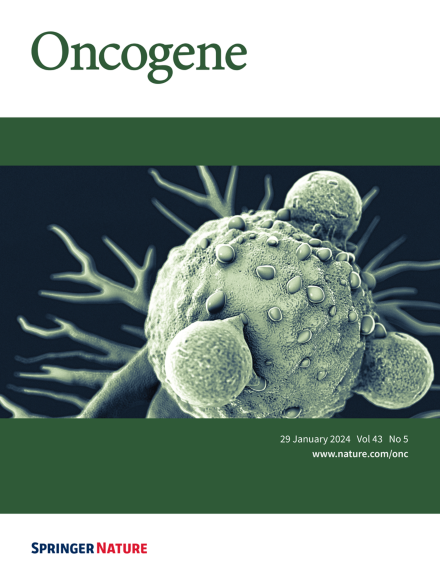角质形成细胞中的核IKKα信号与胞质IKKα信号会导致相反的皮肤表型和炎症反应,以及不同的癌症易感性。
IF 6.9
1区 医学
Q1 BIOCHEMISTRY & MOLECULAR BIOLOGY
引用次数: 0
摘要
众所周知,IKKα是皮肤稳态的重要蛋白。然而,由于缺乏合适的模型来研究其在皮肤中的功能,IKKα被误认为是非黑色素瘤皮肤癌(NMSC)发生的抑制因子。在本研究中,我们利用之前生成的在基底角质形成细胞的细胞质(C-IKKα小鼠)或细胞核(N-IKKα小鼠)中表达外源IKKα的转基因小鼠模型,证明了在每一种亚细胞定位方式下,IKKα对维持角质形成细胞增殖和分化之间的平衡以及皮肤炎症反应的信号通路都有不同的调节作用。此外,每种类型的 IKKα 转基因小鼠都表现出不同的自发性 NMSC 易感性。具体来说,N-IKKα小鼠的表皮萎缩,末端分化加剧,出现皮肤早衰、恶性前病变的迹象,并发展成鳞状细胞癌(SCC)。相反,C-IKKα小鼠的角质形成细胞中几乎没有内源性核IKKα,虽然它们表现出增生性皮肤,表皮末端分化不足、慢性皮肤炎症以及STAT-3和NF-κB信号通路的持续激活,但它们不会出现皮肤SCC。总之,我们的数据表明,IKKα在角质形成细胞的细胞核或细胞质中的定位改变会引起相反的皮肤变化,并在不同程度上导致皮肤 SCC 的生长。本文章由计算机程序翻译,如有差异,请以英文原文为准。

Nuclear versus cytoplasmic IKKα signaling in keratinocytes leads to opposite skin phenotypes and inflammatory responses, and a different predisposition to cancer
IKKα is known as an essential protein for skin homeostasis. However, the lack of suitable models to investigate its functions in the skin has led to IKKα being mistakenly considered as a suppressor of non-melanoma skin cancer (NMSC) development. In this study, using our previously generated transgenic mouse models expressing exogenous IKKα in the cytoplasm (C-IKKα mice) or in the nucleus (N-IKKα mice) of basal keratinocytes, we demonstrate that at each subcellular localization, IKKα differently regulates signaling pathways important for maintaining the balance between keratinocyte proliferation and differentiation, and for the cutaneous inflammatory response. In addition, each type of IKKα-transgenic mice shows different predisposition to the development of spontaneous NMSC. Specifically, N-IKKα mice display an atrophic epidermis with exacerbated terminal differentiation, signs of premature skin aging, premalignant lesions, and develop squamous cell carcinomas (SCCs). Conversely, C-IKKα mice, whose keratinocytes are nearly devoid of endogenous nuclear IKKα, do not develop skin SCCs, although they exhibit hyperplastic skin with deficiencies in terminal epidermal differentiation, chronic cutaneous inflammation, and constitutive activation of STAT-3 and NF-κB signaling pathways. Altogether, our data demonstrate that alterations in the localization of IKKα in the nucleus or cytoplasm of keratinocytes cause opposite skin changes and differentially predispose to the growth of skin SCCs.
求助全文
通过发布文献求助,成功后即可免费获取论文全文。
去求助
来源期刊

Oncogene
医学-生化与分子生物学
CiteScore
15.30
自引率
1.20%
发文量
404
审稿时长
1 months
期刊介绍:
Oncogene is dedicated to advancing our understanding of cancer processes through the publication of exceptional research. The journal seeks to disseminate work that challenges conventional theories and contributes to establishing new paradigms in the etio-pathogenesis, diagnosis, treatment, or prevention of cancers. Emphasis is placed on research shedding light on processes driving metastatic spread and providing crucial insights into cancer biology beyond existing knowledge.
Areas covered include the cellular and molecular biology of cancer, resistance to cancer therapies, and the development of improved approaches to enhance survival. Oncogene spans the spectrum of cancer biology, from fundamental and theoretical work to translational, applied, and clinical research, including early and late Phase clinical trials, particularly those with biologic and translational endpoints.
 求助内容:
求助内容: 应助结果提醒方式:
应助结果提醒方式:


